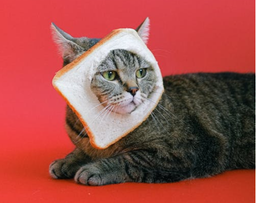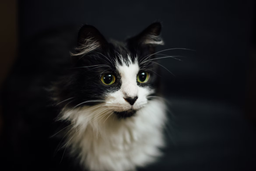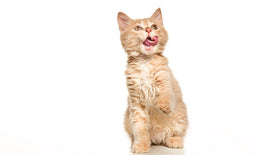Hyperthyroidism in cats—an adequate diet and other potential treatments
Hyperthyroidism is common among all cat breeds, especially as they approach their golden years. While it’s an incurable metabolic disorder, it’s far from a death sentence. With proper care and support, your house pet will enjoy a long and comfortable life.
Some lifestyle changes are necessary after your feline friend has been diagnosed with an overactive thyroid. Let’s start with the most questionable home remedy for hyperthyroidism in cats—a diet with little to no iodine. Does it help? We’ll examine the pros and cons of iodine-free food and see if tailor-made meals can help control the condition!
Low iodine diet for cats—can it help?
Unlike humans, cats have two separate thyroid glands in their neck, one on each side of the trachea (windpipe). The thyroid glands are responsible for regulating the feline’s metabolic functions.
As your cat matures, their thyroid can thicken or enlarge and start producing too many thyroid hormones, mainly T3 and T4. The increase in production, often followed by tissue abnormalities, is called hyperthyroidism.
The most common symptoms are:
- Sudden weight loss
- Vomiting
- Diarrhoea
- Increased appetite
- Increased thirst
- Frequent urination
- Respiratory problems
- Matted fur
- Behavioural changes
Hyperthyroidism is mostly benign, with less than 2% of cats developing malignant tumours on the gland. The real issue is the effect the disease has on other organs, especially the heart. An overactive thyroid can cause secondary problems, such as hypertension and thyrotoxic cardiomyopathy (enlarged heart).
Although high blood pressure and heart problems can sometimes be reversed, cats still require medical attention in the form of oral medication, iodine therapy, and dietary adjustments (occasionally).
The feline body requires iodine to create thyroxine, i.e., thyroid hormones. According to a one-year study, restricted iodine intake can control hyperthyroidism in some felines, but further research is required. Some experts are concerned with the inconclusive results of an entirely iodine-free diet for cats, while others claim it’s necessary.
If you want to try limiting the iodine content in your pet’s meals, consult your vet first. Every cat has unique needs, especially when it comes to nutrition. Hyperthyroidism also manifests differently in individual felines, so there are several potential treatments.
Before you put your pet on a restrictive diet, you must consider their life stage, sterilisation status, overall health, and specific sensitivities.
What’s the best food for cats with thyroid problems?

You can never go wrong with a high-protein diet!
Image (c) Untamed
Cats with chronic conditions are sometimes placed on a prescription diet. If your cat was diagnosed with hyperthyroidism, the vet might recommend using low-iodine cat food. The products are formulated to regulate the feline’s hyperactive glands by reducing the iodine content.
Keep in mind that the effectiveness of the low iodine diet for cats varies.
Since hyperthyroidism in cats is often treated with radioactive iodine and various oral medications, dietary therapy may not be necessary. You can try adhering to their natural feeding pattern and eliminating any food that could cause further complications, like processed meat or dairy.
Is there any natural food for cats with hyperthyroidism that simultaneously caters to their dietary needs? The ultimate feline superfood—unprocessed meat! Here’s a shortlist of meat with low iodine content:
- Chicken
- Turkey
- Liver
- Carp
- Trout
- Bass
You should avoid giving raw or undercooked meat to your cat because of the potential risks. Raw food, including meat, milk, and eggs, contains harmful bacteria that could lead to severe infections or death.
Looking for a high-quality diet for hyperthyroid cats? Get Untamed!
Hyperthyroidism doesn’t have to get in the way of your cat’s happiness! Untamed will make sure your feline friend lives a long and fulfilling life. Our nourishing recipes will keep your pet’s metabolism in check and ensure their quality of life remains the same.
We’ve worked hard to come up with the ultimate feline diet. Each Untamed meal is:
- Full of protein—The protein content in a single serving of Untamed food is twice the industry standard. We don’t use vegetables, meat derivatives, or other useless or harmful substances in our delicacies
- Made with whole meat—We use human-grade quality meat for our tasty and nourishing meals. The final product is packed with bioavailable nutrients your furry companion needs to thrive
- Vet-formulated—Untamed consulted vets to design the best diet for cats. Each dish is nutrient-dense and free of common allergens
- Ethically produced—Untamed packaging is recyclable. We get our ingredients from sustainable sources and leave a neutral carbon footprint, refraining from mass production
- Irresistible and delicious—Our dishes are tasty and nourishing. Watch your finicky eater give in to Untamed as soon as you open the can
We preserve the original bioavailability by steaming the ingredients gently. With all the goodness locked in, your kitty will feel the famous Untamed effect immediately! Here are some short- and long-term health benefits of Untamed:
|
Timeline |
Health benefits |
|
Within a week |
|
|
After two months |
|
|
Within four months |
|
|
Life-long benefits |
|
Check out our delicious recipes!
We use fresh, high-quality meat cuts, such as:
- Chicken breast and liver
- Duck breast
- Salmon fillet
- Tuna steak
- Sardine and mackerel fillet
Check out our recipes and treat your feline with the tastiest healthy food on the market:
- Chocka Chicken in Jelly—Extra moist chicken breasts soaked in light jelly for sensitive kitties who like simple meals
- Tuck-in Tuna in Jelly—Dolphin-safe tuna simmered in jelly and hearty fish broth for cats who prefer seafood
- Chocka Chicken with Duck in Jelly—The poultry platter for felines with delicate taste buds, high-quality chicken breast mixed with whole duck meat, dipped in jelly
- Tuck-in Tuna with Salmon in Jelly—Delicious salmon fillet gives an extra kick to fresh tuna soaked in jelly
- Chocka Chicken in Gravy—A complete dish for the sensitive feline, shredded chicken breast are steamed in natural gravy to entice picky eaters
Take the Untamed online quiz and get our diverse starter pack at the best price!

Untamed’s Chocka Chicken in Jelly nurtures the feline body, providing the essential macronutrients all cats need to thrive!
Image (c) Untamed
How to order Untamed delicacies
If you become a member of the Untamed clowder, your pet will have a feast every day! With us, you can buy cat food in bulk online, but first, order our taster pack to let your kitty check out our menu:
- Visit our Try Now page
- Tell us more about your furry companion
- Pick the goods and place the order
We'll deliver your custom-made meal box within a day, with no additional shipping fees! Once your cat samples everything, let us know if they liked it, and we’ll deliver the goods around the same time every month.
Our nifty cat food service is dedicated to your needs. If you wish to change, postpone, or cancel your order, you may do so from your account.
Wet vs. dry food, what’s better for hyperthyroid cats?

Quite frankly, I couldn’t care less about the iodine—I’m more interested in the flavour!
Image (c) Untamed
In sickness and in health, your cat is an obligate carnivore and needs a well-balanced diet with the following nutrient ratio:
|
Nutrient |
Desired intake |
|
Protein |
More than 50% |
|
Fat |
Up to 20% |
|
Carbohydrate |
Less than 3% |
High-quality wet food is much closer to these parameters than other types of cat food, especially kibble. Semi-moist and moist products are usually rich in animal protein—the only viable source of taurine—and bioavailable vitamins and minerals.
Wet food also has a high moisture content (78%), which is especially important for hyperthyroid cats since they are prone to kidney disease.
Kibble is significantly less hydrating, with only 10% moisture on average, which is why many cat parents serve it with soup or broth. Dry cat food is also highly caloric, so it can help with malnutrition recovery. If you’re thinking, “so that’s how to make a hyperthyroid cat gain weight,” sadly, you’d be mistaken.
Even though cats who suffer from hyperthyroidism often experience drastic weight loss, stuffing them with dry biscuits won’t help them bounce back. The excess carbs could further impair their metabolic function and burden their vital organs, potentially leading to other disorders.
If your cat is already hooked on kibble, try getting them on a mixed diet of wet and dry food until they warm up to canned food.
Iodine-free food your cat shouldn’t eat regularly (or at all)
The following food items are low in iodine but are useless or potentially harmful to hyperthyroid cats:
- Vegetables—Overactive thyroid or not, your cat shouldn’t be a vegan! While some low-iodine fruits like strawberries, pumpkins, apples, and bananas are neutral, others can be quite harmful. For example, grapes and citrus fruits can damage your cat’s kidneys, while allium vegetables are poisonous
- Pork—Pork and pork derivatives, such as bacon, contain too much sodium and saturated fats. Hyperthyroid cats often have high blood pressure, so you should avoid feeding them fatty meats and charcuterie delicacies. You can add some high-quality ham to spice up your kitty’s meals but in moderation
- Grain—Barley, oats, wheat, rice, and grain-based foods like bread and pasta add no nutritional value to your cat’s diet. Grains are mostly used as fillers in low-quality cat food to bulk up the volume. While not harmful to cats, they can’t help with an overactive thyroid or other metabolic dysfunctions like diabetes
- Chocolate, coffee, or tea—Caffeine puts a strain on the feline heart, especially when consumed in large quantities. Your cat can get caffeine poisoning and develop symptoms like heart palpitations, muscle tremors, and shortness of breath. They are also common manifestations of hyperthyroidism, so it’s best to avoid chocolate, coffee, and tea altogether

Even if your cat is cuckoo for cocoa, it’ll only make their symptoms worse.
Source: Rodrigo Flores
Overactive thyroid in cats
Hyperthyroidism is common in senior cats. Kittens and adult felines below the age of 13 are less likely to develop the disease.
Unlike other metabolic disorders, such as type one diabetes, hyperthyroidism isn’t related to genetics, although there are fewer cases among certain breeds (for example, Siamese and Persian cats).
The cause of hyperthyroidism is still unknown, but some attribute it to external factors, such as a surplus of iodine in the diet. That’s why vets sometimes prescribe iodine-free cat food as a form of treatment.
Common symptoms of the disease include:
- Weight loss despite the increased appetite
- Increased thirst and urination
- Vomiting
- Diarrhoea
- Restlessness
- Difficulty breathing
- Heart murmur
- Greasy or matted fur
- Lump on the neck
- Weakness and lethargy
- Aggression
If your vet suspects your cat has an overactive thyroid, they will perform a physical exam and request a blood chemistry panel, coupled with a thyroid hormone level study. The physical exam isn’t invasive in the slightest—the vet will merely feel your cat's neck to check for an enlarged thyroid gland. They will also check your cat's heart rate and blood pressure.
Treatment
Besides a low-iodine diet, other therapeutic options for feline hyperthyroidism include:
- Medication—Lifelong administration of anti-thyroid drugs can help control the effects of hyperthyroidism. Besides oral medication, there are gel variants available in pet pharmacies. Your vet will most likely prescribe methimazole to block the overproduction of thyroid hormones and maintain normal metabolic function. Some side effects include lethargy, nausea, vomiting, fever, and anaemia. Methimazole should stabilise a hyperthyroid cat experiencing heart complications, but the drug is mostly prescribed for life as a preventive treatment
- Radioactive iodine therapy—Regular injections of radioactive iodine are an effective way to control your cat’s hyperthyroidism. The enlarged gland absorbs the iodine directly from the bloodstream, allowing the radiation to destroy the abnormal tissue. It’s an entirely safe procedure, so you don’t have to worry about organ damage or radiation poisoning. There’s no need for local or general anaesthesia either. Radioactive therapy eliminates the need for other treatments, particularly the thyroid diet
- Surgery—In some cases, your vet may recommend the removal of the enlarged gland. The procedure eliminates the need for long-term treatment. Your cat will have to take methimazole or another antithyroid drug in the weeks preceding the surgery to lower their blood pressure and, hopefully, gain some weight. The downside to thyroidectomy is it requires total anaesthesia, which poses a risk for older cats
There are benefits and drawbacks to each treatment. Your vet will have to take numerous factors into account, including your cat’s overall health, age, and any specific condition (e,g., pregnancy or nursing).
Besides hyperthyroidism, what other ailments can my ageing cat develop?

Your oldtimer may need extra love and care as they approach the finish line!
Source: avante
Cats can develop several chronic health issues once they’re past their prime. Besides thyroid dysfunction, older cats often suffer from:
- Obesity—Senior felines have less energy than adult cats, let alone kittens. The lethargic behaviour coupled with muscle deterioration and slower digestive tract makes weight control challenging. Make sure they get enough water and encourage them to exercise
- Dental disease—While some breeds are more prone to dental diseases (e.g., Maine Coons), most cats will lose their teeth in the final stretch. The good news is—as long as their gums are healthy, they’ll still be able to eat properly. You’ll have to slightly adjust their diet and give them softer food
- Gastrointestinal problems—Older cats have more sensitive stomachs, meaning they might have trouble digesting the food they previously enjoyed. Their eating habits can change drastically, so prepare to deal with regular bouts of fussiness
- Arthritis—Joint pain and reduced mobility are common in Himalayan, Siamese, and Persian cats, often born with congenital anomalies, such as hip dysplasia. Sadly, there’s no cure for arthritis, but you can help your cat move easily by installing ramps. Dietary supplements, like glucosamine and chondroitin, can assist but be careful. Giving your elderly feline food supplements without consulting the vet can cause urinary tract diseases like bladder stones
- Renal disease—Chronic kidney disease or CKD is a huge risk for senior cats. The symptoms are hard to catch because they coincide with the natural ageing process like weight loss and a shabby-looking coat. An early diagnosis could save your cat’s kidney, so regular check-ups are crucial
- Cognitive impairment—Your cat can develop several cognitive dysfunctions, including Alzheimer’s disease. The onset can be extremely quick or painfully slow, depending on the individual case. It’s difficult to predict whether your cat might become senile, but you can do your best to prevent it. Give them food rich in antioxidants, such as fish and lean meat
While you can’t turn back time, you can ensure your senior cat gets proper care and lots of love.

![Best food for Ragdoll cats in the UK [Broken Down]](http://untamed.com/cdn/shop/articles/featured_best_food_for_ragdoll_cats_uk.jpg?v=1646818249&width=256)

